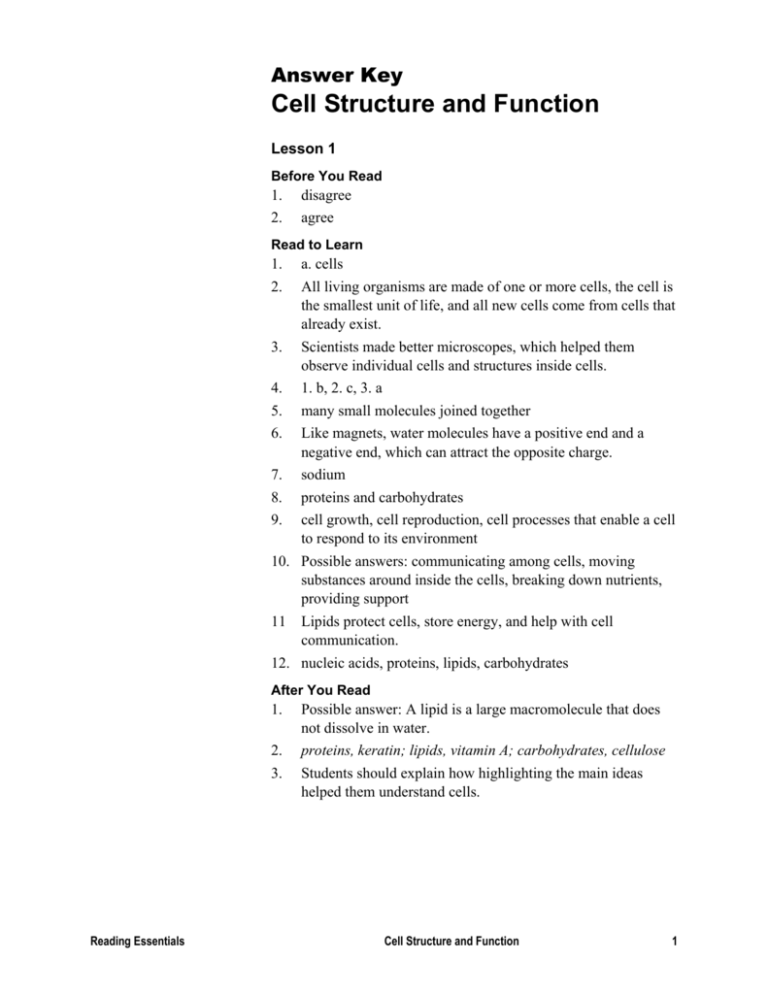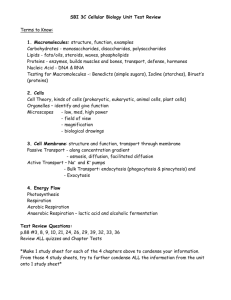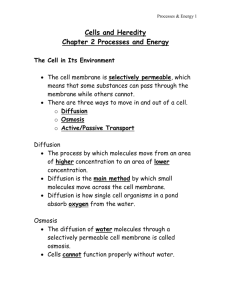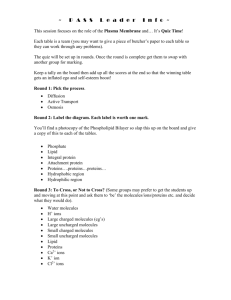Answer Key Reading essentials c.2 Cell Structure and Function
advertisement

Answer Key Cell Structure and Function Lesson 1 Before You Read 1. 2. disagree agree Read to Learn 1. 2. a. cells All living organisms are made of one or more cells, the cell is the smallest unit of life, and all new cells come from cells that already exist. 3. Scientists made better microscopes, which helped them observe individual cells and structures inside cells. 4. 1. b, 2. c, 3. a 5. many small molecules joined together 6. Like magnets, water molecules have a positive end and a negative end, which can attract the opposite charge. 7. sodium 8. proteins and carbohydrates 9. cell growth, cell reproduction, cell processes that enable a cell to respond to its environment 10. Possible answers: communicating among cells, moving substances around inside the cells, breaking down nutrients, providing support 11 Lipids protect cells, store energy, and help with cell communication. 12. nucleic acids, proteins, lipids, carbohydrates After You Read 1. 2. 3. Reading Essentials Possible answer: A lipid is a large macromolecule that does not dissolve in water. proteins, keratin; lipids, vitamin A; carbohydrates, cellulose Students should explain how highlighting the main ideas helped them understand cells. Cell Structure and Function 1 Lesson 2 Before You Read 3. 4. agree disagree Read to Learn 1. 2. 3. 4. 5. 6. 7. 8. 9. The cell wall is outside of the cell membrane. proteins and phospholipids Possible answers: Golgi apparatus, cell membrane, cytoskeleton, smooth endoplasmic reticulum, rough endoplasmic reticulum, mitochondrion, ribosome, vesicle, nucleus and its contents The cytoskeleton is made of threadlike proteins that are joined together. Possible answers: DNA, cell membrane, cell wall, capsule, flagellum, cytoplasm, and ribosome Both have genetic material, which is surrounded by a membrane in eukaryotic cells but not in prokaryotic cells. Eukaryotic cells are larger and have organelles. Prokaryotic cells have fewer cell parts and no organelles. Rough ER has ribosomes on its surface and produces proteins. Smooth ER has no ribosomes on its surface, produces lipids, and helps remove harmful substances from a cell. plant and algae cells prepares proteins for their specific jobs and packages them into tiny membrane-bound structures called vesicles After You Read 1. Possible answer: The nucleus directs all cell activities and stores genetic information. 2. Reading Essentials Organelle Function Chloroplast uses light energy and makes food Golgi apparatus gets proteins ready for their specific jobs; packages them into vesicles Smooth ER makes lipids Nucleus directs cell activities; contains genetic information Cell Structure and Function 2 3. These tasks include getting energy from food, storing information, and getting rid of waste material. Lesson 3 Before You Read 5. 6. disagree agree Read to Learn 1. 2. 3. 4. 5. 6. 7. 8. Only the water in the left side of the beaker would be colored with dye. The water in the right side would remain clear. Diffusion is the movement of any small molecules from an area of higher concentration to an area of lower concentration. Osmosis is the diffusion of water molecules only through a membrane. Carrier proteins carry large molecules through the cell membrane. Channel proteins form pores through membranes that ions pass through. Students should circle carrier proteins. A cell uses its own energy to move substances from areas of lower concentration to areas of higher concentration. either through passive transport—diffusion, osmosis, and facilitated diffusion—or through active transport— endocytosis and exocytosis 54 mm2/27 mm3 = 2/1 = 2:1 vesicle After You Read 1. Possible answer: Active transport uses the cell’s energy to move substances through the membrane, but passive transport does not use the cell’s energy. 2. Active transport Passive transport Reading Essentials Energy needed? yes Structures Involved cell membrane no vesicle cell membrane, channel proteins, carrier proteins Cell Structure and Function Examples exocytosis, endocytosis diffusion, osmosis, facilitated diffusion 3 Lesson 4 Before You Read 7. 8. disagree disagree Read to Learn 1. 2. 3. 4. 5. 6. 7. Students should circle the cytoplasm. Glycolysis breaks down glucose into smaller molecules. Reactions in the mitochondria convert oxygen and these smaller molecules into energy, water, and carbon dioxide. through cellular respiration and fermentation Both make ATP from glucose, but lactic-acid fermentation also produces lactic acid, whereas alcohol fermentation produces alcohol and carbon dioxide. lactic-acid fermentation: ATP and lactic acid; alcohol fermentation: ATP, alcohol, and carbon dioxide Some cells make food molecules through photosynthesis, using light energy, water, and carbon dioxide. Photosynthesis releases oxygen that other organisms can use for cellular respiration. Cellular respiration gives off carbon dioxide that plants can use in photosynthesis. After You Read 1. Possible answer: Cellular respiration makes carbon dioxide and water as waste products. Photosynthesis uses carbon dioxide to make sugars and oxygen, which are used by other organisms during cellular respiration. 2. Photosynthesis What is needed? What is produced? 3. Reading Essentials 1. carbon dioxide 2. water 3. light energy 1. glucose 2. oxygen Cellular Respiration Fermentation 1. glucose 2. oxygen 1. glucose molecules 1. carbon dioxide 2. water 3. ATP 1. lactic acid 2. alcohol 3. carbon dioxide green Cell Structure and Function 4









